Related Research Articles

Mount Everest(also Mount Sagarmatha or Mount Qomolangma) is Earth's highest mountain above sea level, located in the Mahalangur Himal sub-range of the Himalayas. The China–Nepal border runs across its summit point. Its elevation of 8,848.86 m was most recently established in 2020 by the Chinese and Nepali authorities.

In medicine, a prosthesis, or a prosthetic implant, is an artificial device that replaces a missing body part, which may be lost through physical trauma, disease, or a condition present at birth. Prostheses are intended to restore the normal functions of the missing body part. Amputee rehabilitation is primarily coordinated by a physiatrist as part of an inter-disciplinary team consisting of physiatrists, prosthetists, nurses, physical therapists, and occupational therapists. Prostheses can be created by hand or with computer-aided design (CAD), a software interface that helps creators design and analyze the creation with computer-generated 2-D and 3-D graphics as well as analysis and optimization tools.

Glossary of climbing terms relates to rock climbing, mountaineering, and to ice climbing.

Mera Peak is a mountain in the Mahalangur section, Barun sub-section of the Himalaya and administratively in Nepal's Sagarmatha Zone, Sankhuwasabha. At 6,476 metres (21,247 ft) it is classified as a trekking peak. It contains three main summits: Mera North, 6,476 metres (21,247 ft); Mera Central, 6,461 metres (21,198 ft); and Mera South, 6,065 metres (19,898 ft), as well as a smaller "trekking summit", visible as a distinct summit from the south but not marked on most maps of the region.

Mark Joseph Inglis is a New Zealand mountaineer, researcher, winemaker and motivational speaker. He holds a degree in Human Biochemistry from Lincoln University, New Zealand, and has conducted research on leukaemia. He is also an accomplished cyclist and, as a double leg amputee, won a silver medal in the 1 km time trial event at the 2000 Summer Paralympics in Sydney. He is the first double amputee to reach the summit of Mount Everest, the highest mountain in the world above sea level.

David Sharp was an English mountaineer who died near the summit of Mount Everest. His death caused controversy and debate because he was passed by several other climbers heading to and returning from the summit as he was dying, although several others tried to help him.

Everest: Beyond the Limit is a Discovery Channel reality television series about yearly attempts to summit Mount Everest organized and led by New Zealander Russell Brice.
Nawang Sherpa became the first person to climb Mount Everest with a prosthetic leg by reaching the summit on May 16, 2004. He is also the first amputee to reach the summit of Mount Everest on his first attempt, and the first disabled person from Asia to stand on the summit.

John McFall is a British Paralympic sprinter, surgeon, and ESA Project astronaut. In November 2022, he was selected by the European Space Agency to become the first "parastronaut". ESA will do a feasibility study on him flying to space and what needs to be adapted for disabled people.

Hugh Herr is an American rock climber, engineer, and biophysicist. When he was young, both of his legs were amputated below the knee during a blizzard in a rock climbing trip. After months of surgeries and rehabilitation, Herr began climbing again, using specialized prostheses he designed for himself, becoming the first person with a major amputation to perform in a sport on par with elite-level, able-bodied persons. He holds the patents to the Rheo Knee, an active ankle-foot orthosis, which is the world's first powered ankle-foot prosthesis.
Deaf climbers use alternative ways such as commands, hand tactics, and sometimes an Interpreter or hearing aid to assist them with their climb. They are capable of all types of climbing including bouldering, which consists of no ropes and usually a crash pad. Top roping, which uses a pre set anchor at the summit of your climb as well as a belayer who helps manage your climbing rope and your security during your climb. Also lead climbing, which is when the rope is attached to the climber, which the climber then clips onto either pre placed bolt anchors or other temporary anchor devices during the ascent, while the belayer manages the rope as well as the safety of the climber.
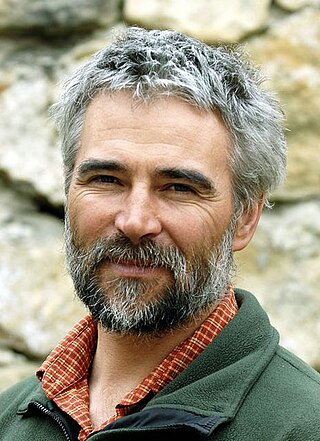
Zsolt Erőss was the most successful Hungarian high-altitude mountaineer, summiting 10 of the 14 eight-thousanders. He was also the first Hungarian citizen to have climbed Mount Everest.
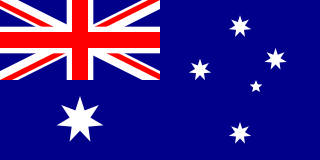
Australia competed at the 2002 Winter Paralympics in Salt Lake City, Utah, United States from 8 March to 19 March 2002. The Salt Lake Paralympics are the eighth such winter games, the first Winter Paralympics ever in North America and the first Winter Paralympics ever set up by an Olympic organizing committee. Although many of the Paralympic expenses were covered by dual planning with the Olympics, organizers still spent about $60 million on the Paralympics, including $5 million on the opening and closing ceremonies. The Salt Lake Games featured 92 events across four sports: alpine skiing, biathlon, cross-country, and ice sledge hockey. The 36 competing countries sent a total of 416 participants. Australia was represented by six male alpine skiers: Peter Boonaerts, Bart Bunting, Michael Milton, Scott Adams, Cameron Rahles-Rahbula, and Mark Drinnan. The medal haul was seven, consisting of six gold and one silver. Australia finished 8th overall in the gold and total medal count, making it the country's most successful Winter Games in terms of gold medals.
T43 is a disability sport classification for disability athletics, applying to athletes with "Double below knee amputation or similar disability." It includes ISOD classified athletes from the A4 and A9 classes.
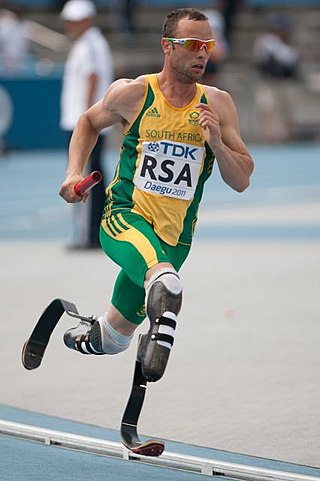
The mechanics of the running blades used by South African former Paralympic runner Oscar Pistorius depend on special carbon-fiber-reinforced polymer prosthetics. Pistorius has double below-the-knee amputations and competed in both non-disabled and T44 amputee athletics events. Pistorius's eligibility to run in international non-disabled events is sanctioned by the International Association of Athletics Federations (IAAF).
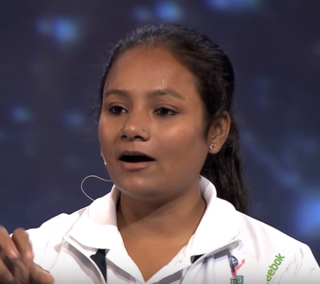
Arunima Sinha is an Indian mountaineer and sportswoman. She is the world's first female amputee to scale Mount Everest (Asia), Mount Kilimanjaro (Africa), Mount Elbrus (Europe), Mount Kosciuszko (Australia), Aconcagua, Denali and Vinson Massif (Antarctica). She is also a seven time Indian volleyball player.
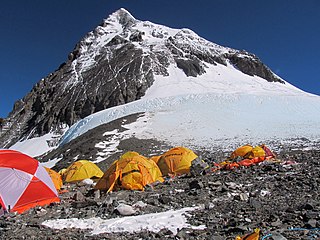
The Mount Everest climbing season of 2013 included 658 summits and 8 deaths. Due to avalanches in 2014 and 2015, this was the last big summiting year until 2016.

Hari Budha Magar is a Nepalese double above-knee amputee and record-breaking mountaineer. In 2017, he became the first double above-knee amputee (DAK) to summit a mountain taller than 6,000m. Then, on May 19, 2023, he accomplished the record of being the first ever double above-knee amputee to summit the world's tallest mountain, Mount Everest (8,848m).

Spencer West is an American motivational speaker and disability advocate. West became an amputee after being born with sacral agenesis. He speaks about overcoming adversity and uses social media to advocate for the disability justice movement and the LGBT community.
Dwayne Fernandes is an Indian-born Australian who holds eight world records for being a double-amputee stair climber competing in the sport of tower running. Fernandes is an advocate for people with disability, and in much of his adult life has worked in various roles focussing on diversity, equity and inclusion in the workplace and in society.
References
- ↑ "Norman Croucher childhood home, Mount Pleasant Farm up for sale". Falmouth Packet . Retrieved 29 November 2021.
- ↑ "Amputee Norman Croucher from Devon takes up paragliding". BBC . Retrieved 29 November 2021.
- ↑ "If the Foot Fits..." (PDF). Retrieved 16 February 2013. Norman Croucher, South American Explorer, No. 5, December 1979
- ↑ "Heriot-Watt University Edinburgh & Scottish Borders: Annual Review 2004". www1.hw.ac.uk. Archived from the original on 13 April 2016. Retrieved 30 March 2016.